This article needs additional citations for verification .(October 2013) |
The national symbols of Bulgaria are the symbols that represent Bulgaria and the Bulgarian people.
This article needs additional citations for verification .(October 2013) |
The national symbols of Bulgaria are the symbols that represent Bulgaria and the Bulgarian people.
| Type | Image | Symbol |
|---|---|---|
| National flag |  | Flag of Bulgaria The flag of Bulgaria (Bulgarian : знаме на България, romanized: Zname na Bǎlgarija, [ˈznamɛ nɐ bɐɫˈɡarijɐ] ) is a tricolour consisting of three equal-sized horizontal bands of (from top to bottom) white, green, and red. It was first adopted after the Russo-Turkish War (1877–1878), where Bulgaria regained independence. At times, the national flag was charged with the state emblem, especially during the People's Republic of Bulgaria. The current flag was re-established with the 1991 Constitution of Bulgaria and was confirmed in a 1998 law. |
| Coat of arms |  | Coat of arms of Bulgaria The coat of arms of Bulgaria (Bulgarian : Герб на България, [ˈɡɛrp nɐ bɐɫˈɡarijɐ] ) consists of a crowned golden lion rampant over a dark red shield; above the shield is the Bulgarian historical crown. The shield is supported by two crowned golden lions rampant; below the shield there is compartment in the shape of oak twigs and white bands with the national motto "Unity makes strength" inscribed on them. |
| National anthem | Mila Rodino "Mila Rodino" ("Мила Родино" [ˈmiɫɐ ˈrɔdino] , translated as "Dear Motherland" or "Dear native land") is the current national anthem of Bulgaria. It is based on the music and text of the song "Gorda Stara Planina" by Tsvetan Radoslavov, written and composed as he left to fight in the Serbo-Bulgarian War in 1885. The anthem was adopted in 1964. The text has been changed many times, most recently in 1990. | |
| Type | Image | Symbol |
|---|---|---|
| Cyrillic alphabet | 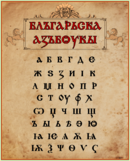 | The Cyrillic script /sɪˈrɪlɪk/ is an alphabetic writing system employed across Eastern Europe and north and central Asia. It is based on the Early Cyrillic, which was developed during the First Bulgarian Empire in the 9th century AD at the Preslav Literary School. [1] [2] [3] With the accession of Bulgaria to the European Union on 1 January 2007, Cyrillic became the third official script of the European Union, following the Latin script and Greek script. [4] |
| Lion (heraldry) |  | The earliest example of a lion's image as the heraldic symbol of Bulgaria is documented in the Lord Marshal's Roll, [5] composed around 1294 AD and preserved in a copy from about 1640. In its first part under No.15 is represented the coat of arms of Le Rey de Bugrie or the King of Bulgaria, most probably this of Tsar Smilets (1292–1298) or may be some of his recent predecessors. It consists of an argent lion rampant with golden crown over sable shield. In the end of the 14th century an anonymous Arab traveller, who visited the capital of the Second Bulgarian Empire Tarnovo, saw and depicted three lions guardant passant gules painted on the round golden shields carried by the personal guards of Tsar Ivan Shishman (1371–1395). His manuscript is now kept in the National Library of Morocco. [6] |
| National hero |  | Vasil Levski [7] (Bulgarian : Васил Левски, originally spelled Василъ Лѣвскій, [8] pronounced [vɐˈsiɫ ˈlɛfski] ), born Vasil Ivanov Kunchev [9] (Васил Иванов Кунчев; 18 July 1837 – 18 February 1873), was a Bulgarian revolutionary and is a national hero of Bulgaria. Dubbed the Apostle of Freedom, Levski ideologised and strategised a revolutionary movement to liberate Bulgaria from Ottoman rule. Founding the Internal Revolutionary Organisation, Levski sought to foment a nationwide uprising through a network of secret regional committees. |
| Patron saint |  | Saint John of Rila (Bulgarian: Свети Йоан (Иван) Рилски, sveti Ioan Rilski) (876 – c. 946) was the first Bulgarian hermit. He was revered as a saint while he was still alive. The legend surrounding him tells of wild animals that freely came up to him and birds that landed in his hands. His followers founded many churches in his honor, including the famous Rila Monastery. One of these churches, "St Ivan Rilski" was only discovered in 2008 in the town of Veliko Tarnovo. Today, he is honored as the patron saint of the Bulgarians and as one of the most important saints in the Bulgarian Orthodox Church. |
| Folk dances (Horo) |  | The Bulgarian dances (Horo) (Bulgarian : Хоро), are intimately related to the music of Bulgaria. This distinctive feature of Balkan folk music is the asymmetrical meter, built up around various combinations of 'quick' and 'slow' beats. The music, in Western musical notation, is often described using compound meter notation, where the notational meter accents, i.e., the heard beats, can be of different lengths, usually 1, 2, 3 or 4. |
| National drink |  | Rakia (Fruit brandy) is the national drink of Bulgaria. Currently, there is no defined origin of rakia but there are many who claim to be the origins of the drink, most vocally Bulgaria. A recent discovery by a team of archaeologists led by Philip Petrunov discovered near the fortress "Lyutitsa" (in Ivaylovgrad) fragment of the distillation container for the production of rakia. According to experts discovery dates back to the 11th century AD and this proves that rakia is produced and consumed in Bulgaria in the 11th century AD. Unknown Bulgarian nobleman from Veliko Tarnovo, in the 14th century wrote on a glass that drinking rakia during the Church Holiday. In support of that rakia in Bulgaria was known before the invasion of the Ottomans is justification of the Turkish commander Lala Sahin to the Ottoman sultan that in 1382 failed to conquer Sofia, because "the defense of the city was entrusted to strong, healthy Bulgarians "with mustaches" that before battle drank rakia and so became invincible". |
| National monument(s) |  | The Madara Rider or Madara Horseman (Bulgarian : Мадарски конник, Madarski konnik) is an early medieval large rock relief carved on the Madara Plateau east of Shumen in northeastern Bulgaria, near the village of Madara. The monument is dated in the very late 7th, [10] or more often very early 8th century, during the reign of Bulgarian Khan Tervel. [10] [11] In 1979 became enlisted on the UNESCO World Heritage List. |
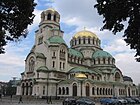 | The St. Alexander Nevsky Cathedral (Bulgarian : Храм-паметник „Свети Александър Невски“, Hram-pametnik „Sveti Aleksandar Nevski“) is a Bulgarian Orthodox cathedral in Sofia, the capital of Bulgaria. Built in Neo-Byzantine style, it serves as the cathedral church of the Patriarch of Bulgaria and is one of the largest Eastern Orthodox cathedrals in the world, as well as one of Sofia's symbols and primary tourist attractions. [12] [13] The St. Alexander Nevsky Cathedral in Sofia occupies an area of 3,170 square metres (34,100 sq ft) and can hold 10,000 people inside. [12] | |
 | The Monastery of Saint Ivan of Rila, better known as the Rila Monastery (Bulgarian : Рилски манастир, Rilski manastir) is the largest and most famous Eastern Orthodox monastery in Bulgaria. It is situated in the southwestern Rila Mountains, 117 km (73 mi) south of the capital Sofia in the deep valley of the Rilska River at an elevation of 1,147 m (3,763 ft) above sea level, inside of Rila Monastery Nature Park. The monastery is named after its founder, the hermit Ivan of Rila (876 - 946 AD). | |
| Adornment |  | A Martenitsa (Bulgarian : мартеница, pronounced [ˈmartɛnit͡sa] ) is a small piece of adornment, made of white and red yarn and usually in the form of two dolls, a male and a female. Martenitsi are worn from Baba Marta Day (1 March) until the wearer first sees a stork, swallow, or budding tree (or until late March). The name of the holiday means "Grandma March" in Bulgarian and the holiday and the wearing of Martenitsi are a Bulgarian tradition related to welcoming the spring, which according to Bulgarian folklore begins in March. [14] |
| National instrument |  | The kaba gaida is a Bulgarian musical bagpipe instrument similar to the gaida. It is larger and lower pitched than the typical gaida. It is native to the Rhodope Mountains of Bulgaria. Nowadays the most common drone tone on a kaba gaida is E. |

The Cyrillic script, Slavonic script or the Slavic script is a writing system used for various languages across Eurasia. It is the designated national script in various Slavic, Turkic, Mongolic, Uralic, Caucasian and Iranic-speaking countries in Southeastern Europe, Eastern Europe, the Caucasus, Central Asia, North Asia, and East Asia, and used by many other minority languages.

Cyril and Methodius (815–885) were brothers, Byzantine Christian theologians and missionaries. For their work evangelizing the Slavs, they are known as the "Apostles to the Slavs".
The Slavs or Slavic peoples are the most populous European ethnolinguistic group. They speak the various Slavic languages, belonging to the larger Balto-Slavic branch of the Indo-European language family. Slavs are geographically distributed throughout the northern parts of Eurasia; they predominantly inhabit Central Europe, Eastern Europe, and Southeastern Europe, though there is a large Slavic minority scattered across the Baltics, Northern Asia, and Central Asia. Continued immigration has resulted in the development of a substantial Slavic diaspora in the Americas.
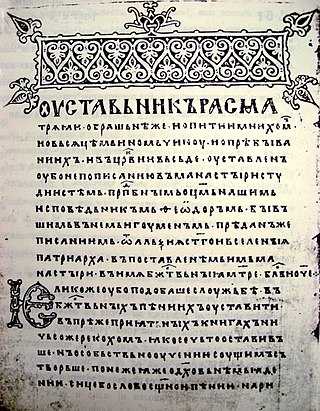
Old Church Slavonic or Old Slavonic was the first Slavic literary language.

Bulgarians are a nation and South Slavic ethnic group native to Bulgaria and its neighboring region, who share a common Bulgarian ancestry, culture, history and language. They form the majority of the population in Bulgaria, while in North Macedonia, Ukraine, Moldova, Serbia, Romania, Hungary, Albania and Greece they exist as historical communities.
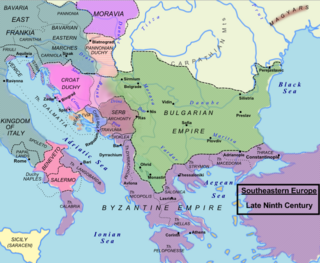
The Principality of Serbia was one of the early medieval states of the Serbs, located in the western regions of Southeastern Europe. It existed from the 8th century up to c. 969–971 and was ruled by the Vlastimirović dynasty. Its first ruler known by name was Višeslav who started ruling around 780. While by that time, starting from the year 680–681, the Bulgarian state had taken the lands to the east. Vlastimir resisted and defeated the Bulgarian army in a three-year-war (839–842), and the two powers lived in peace for some decades. Vlastimir's three sons succeeded in ruling Serbia together, although not for long; Serbia became a key part in the power struggle between the Byzantines and Bulgarians, predominantly allied with the Byzantines, which also resulted in major dynastic wars for a period of three decades. The principality was annexed in 924 by Simeon I and subjected to Bulgarian rule until 927 when Serbian prince Časlav was established as ruler of the Serbian land, and united several Serbian regions, becoming the most powerful ruler of the Vlastimirović dynasty.

Tsar SimeonI the Great ruled over Bulgaria from 893 to 927, during the First Bulgarian Empire. Simeon's successful campaigns against the Byzantines, Magyars and Serbs led Bulgaria to its greatest territorial expansion ever, making it the most powerful state in contemporary Eastern and Southeast Europe. His reign was also a period of unmatched cultural prosperity and enlightenment later deemed the Golden Age of Bulgarian culture.

The Serbian Orthodox Church is one of the autocephalous Eastern Orthodox Christian churches.

Macedonians are a nation and a South Slavic ethnic group native to the region of Macedonia in Southeast Europe. They speak Macedonian, a South Slavic language. The large majority of Macedonians identify as Eastern Orthodox Christians, who speak a South Slavic language, and share a cultural and historical "Orthodox Byzantine–Slavic heritage" with their neighbours. About two-thirds of all ethnic Macedonians live in North Macedonia and there are also communities in a number of other countries.

The Early Cyrillic alphabet, also called classical Cyrillic or paleo-Cyrillic, is a writing system that was developed in Medieval Bulgaria in the Preslav Literary School during the late 9th century. The modern Cyrillic script is used for some Slavic languages, and for East European and Asian languages that have experienced a great amount of Russian cultural influence.

Naum, also known as Naum of Ohrid or Naum of Preslav was a medieval Bulgarian writer, enlightener, one of the Seven Apostles of the First Bulgarian Empire and missionary among the Slavs. He was among the disciples of Cyril and Methodius and is associated with the creation of the Glagolitic and Cyrillic script. Naum was among the founders of the Pliska Literary School. Afterwards Naum worked at the Ohrid Literary School. He was among the first saints declared by the Bulgarian Orthodox Church after its foundation in the 9th century. The mission of Naum played significant role by transformation of the local Early Slavs into Bulgarians.
Chernorizets Hrabar was a Bulgarian monk, scholar and writer who worked at the Preslav Literary School in the First Bulgarian Empire at the end of the 9th and the beginning of the 10th century.

The Vlastimirović was the first Serbian royal dynasty, named after Prince Vlastimir, who was recognized by the Byzantine Empire. The dynasty was established with the Unknown Archon, who ruled during the reign of Emperor Heraclius (610–641). The Vlastimirović dynasty ruled in Serbia until the 960s, when some of the Serbian lands were annexed by the Byzantine Empire.
The following is a timeline of major events in post-classical history from the 5th to 15th centuries, loosely corresponding to the Old World Middle Ages, intermediate between Late antiquity and the early modern period.
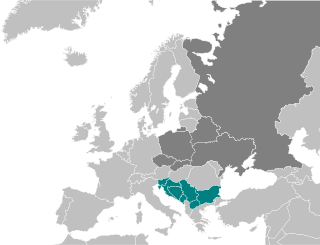
South Slavs are Slavic people who speak South Slavic languages and inhabit a contiguous region of Southeast Europe comprising the eastern Alps and the Balkan Peninsula. Geographically separated from the West Slavs and East Slavs by Austria, Hungary, Romania, and the Black Sea, the South Slavs today include Bosniaks, Bulgarians, Croats, Macedonians, Montenegrins, Serbs and Slovenes.

Mutimir was prince of Serbia from ca. 850 until 891. He defeated the Bulgar army, allied himself with the Byzantine emperor and ruled the first Serbian Principality when the Christianization of the Serbs took place and the Eparchy of Ras was established.

The Church of Saints Clement and Panteleimon is a Byzantine church situated on Plaošnik in Ohrid, North Macedonia. It is attributed to Saint Clement of Ohrid, a disciple of Saint Cyril and Saint Methodius. Archaeologists have come to believe that the church is located on the site where the first students of the Glagolitic alphabet were taught in the First Bulgarian Empire.
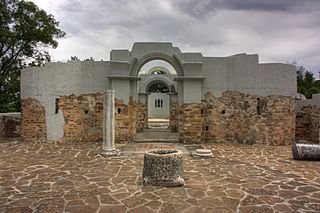
The Round Church, also known as the Golden Church or the Church of St John, is a large partially preserved early medieval Eastern Orthodox church. It lies in Preslav, the former capital of the First Bulgarian Empire, today a town in northeastern Bulgaria. The church dates to the early 10th century, the time of Tsar Simeon I's rule, and was unearthed and first archaeologically examined in 1927–1928.
Saint Clement or Kliment of Ohrid was one of the first medieval Bulgarian saints, scholar, writer, and apostle to the Slavs. He was one of the most prominent disciples of Cyril and Methodius and is often associated with the creation of the Glagolitic and Cyrillic scripts, especially their popularisation among Christianised Slavs. He was the founder of the Ohrid Literary School and is regarded as a patron of education and language by some Slavic people. He is considered to be the first bishop of the Bulgarian Orthodox Church, one of the Seven Apostles of Bulgarian Orthodox Church since the 10th century, and one of the premier saints of modern Bulgaria. The mission of Clement was the crucial factor which transformed the Slavs in then Kutmichevitsa into Bulgarians. Clement is also the patron saint of North Macedonia, the city of Ohrid and the Macedonian Orthodox Church.
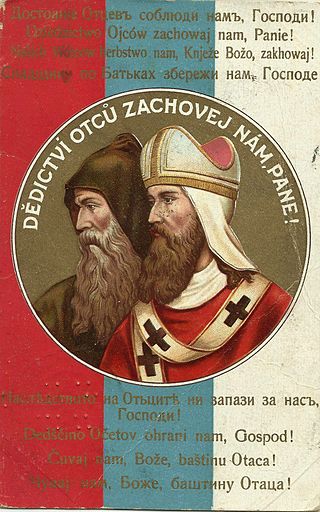
The Slavs were Christianized in waves from the 7th to 12th century, though the process of replacing old Slavic religious practices began as early as the 6th century. Generally speaking, the monarchs of the South Slavs adopted Christianity in the 9th century, the East Slavs in the 10th, and the West Slavs between the 9th and 12th century. Saints Cyril and Methodius are attributed as "Apostles to the Slavs", having introduced the Byzantine-Slavic rite and Glagolitic alphabet, the oldest known Slavic alphabet and basis for the Early Cyrillic alphabet.
The Psalter and the Book of Prophets were adapted or "modernized" with special regard to their use in Bulgarian churches, and it was in this school that glagolitic writing was replaced by the so-called Cyrillic writing, which was more akin to the Greek uncial, simplified matters considerably and is still used by the Orthodox Slavs.